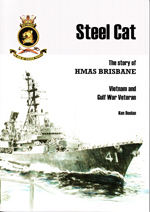
Steel Cat: the story of HMAS Brisbane, Vietnam and Gulf War Veteran
by Ken Doolan: Grinkle Press, 2009. ISBN 9780980282115. 208PP.
RRP $22 +$10 postage
Reviewed by Ian Pfennigwerth, Proud veteran of DDGs Brisbane and Perth
WHY review a four-year-old book? Because I think that it is worth consideration, even more so now as international events have demonstrated ever more clearly the value to Australia of ships like our lost guided missile destroyers. Ken Doolan was one of 25 fortunate men to have commanded Her Majesty’s Australian Ship Brisbane, last of three guided missile destroyers (DDG) commissioned into the RAN in the 1960s, and the story he tells is not of the ‘Boys’ Own’ variety, although the ships themselves inspired that kind of reaction.
At Brisbane’s decommissioning in October 2001 the Chief of Navy, another DDG veteran, remarked; ‘They were the first, post-Second World War ships…that had real grunt. They had a missile system that worked. They had guns that were accurate and hit the target. They had sonar that worried submariners – and they travelled at a real destroyer’s speed’.
Doolan’s account, however, is measured and methodical, and his first chapter on the origins of the decision to purchase the DDGs is a significant contribution to Australia’s naval history. Whether one can conclude that the RAN owed the DDGs to the Royal Australian Air Force overreaching itself in its purported capacity to provide air defence to the Fleet is a matter for the individual reader, but it was far from an off-the-cuff decision by Vice Admiral Burrell on his visit to the US in 1960. That it was a decision of enormous consequence, to the fighting power of the RAN and in cementing relationships with the United States, Doolan clearly demonstrates.
The author then describes the process of ordering and construction, fitting out, working up and reaching an appropriate level of proficiency in the operation of this new weapon system, which provided the RAN with its first real opportunity to benchmark itself against the performance standards of the larger navy. As he says, the flow-on effects on the rest of the fleet, regardless of its origins, were important for an RAN still struggling with post-Voyager issues.
The chapters on the ship’s two Vietnam deployments follow familiar lines, although it is worth noting the care and attention that went into the preparation of the ship for her deployments and the improvements these demanded in RAN practice for preparing ships for active service. The author notes the distinct drop in the operational tempo of the second deployment in comparison with the first, but her duties still demanded of Brisbane a high standard of professional competence she demonstrated repeatedly.
A short chapter describes the ship’s role in Operation NAVY HELP DARWIN in the wake of the Cyclone Tracy disaster. First ship to reach the stricken city on 31 December 1974, Brisbane was the last to depart on 31 January 1975. With an average of 160 of her men ashore during that month, the DDG accomplished much for the citizens and their city in that critical period. The following chapter outlines the ship’s 1977 deployment to Europe for the Queen’s Jubilee Review and exercises with NATO navies, an opportunity to test the ship’s operational readiness in a different environment.
Chapter 8, dealing with the ship’s capability upgrades in the 1980s and her North West Indian Ocean deployments of the late 1980s, is an interesting and timely introduction to the following chapter. More space could have been devoted to discussing the ramifications on the RAN and Australian Defence of the modernisations which took the RAN’s DDG’s from post-World War II competency into the late 20th century.
Ken Doolan rose to the rank of Rear Admiral and was the Maritime Commander during the first Gulf War in 1991. In this book he has lifted the corner of the veil over what admirals really do, just a little, to describe the activities behind the scenes which accompanied the RAN’s deployment – Operation DAMASK. His remarks on p.124 on how the Government selects ships for its navy are worth the price of the book, as is his description of how the RAN struggled to get so-called ‘Tier 2 ‘ ships up to the standards required for a ‘Tier 1’ war in a matter of weeks. The deployment was a triumph of hard work and ingenuity, and the commitment of men and women who served in and supported Brisbane and the other ships. The DDG spent a continuous 46 days in the front line in the Arabian Gulf – a tribute to her company and command.
The final chapters concern the rundown of the ship towards her decommissioning and an interesting one on the disposal of the ship, by no means a simple task of knocking holes in her bottom and sinking her off the Sunshine Coast. However, as a result there are plenty of reminders of Brisbane, not least her bridge superstructure and forward gun mount outside the Australian War Memorial in Canberra.
And the ‘Steel Cat’ nickname? It was certainly adopted during in Vietnam, as Doolan describes in his Preface, but it also alludes to the leopard that tops the crest of the City of Brisbane and which appears on the ship’s crest. Heraldry experts tell us that the leopard conveys the attributes of ‘valour, honour and high-mettle’, all very surely associated with the long and distinguished career of HMAS Brisbane.



